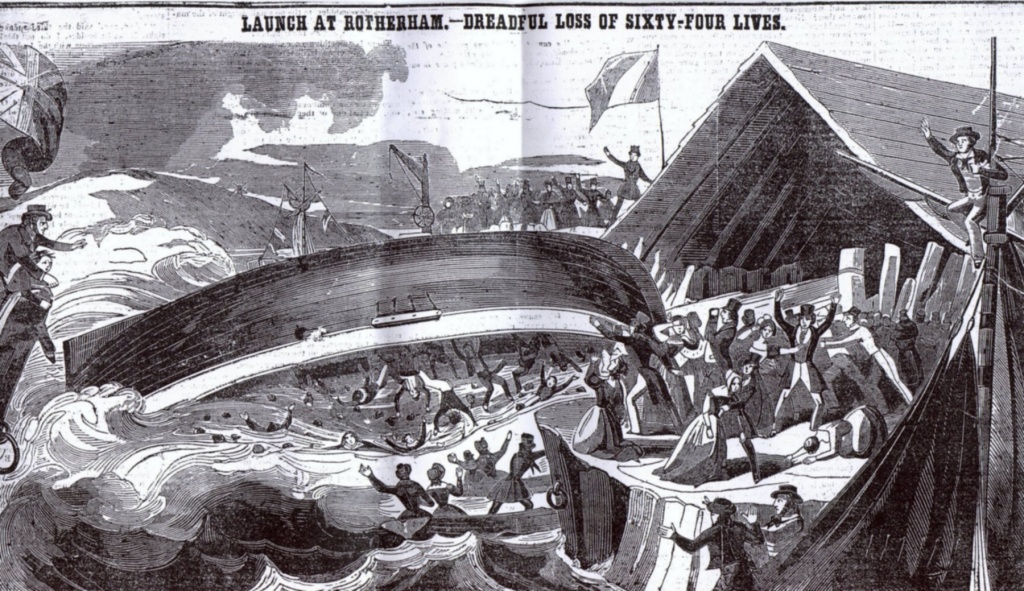The Masbro’ boat disaster occurred on the River Don in Masbrough, Yorkshire on 5 July 1841. The incident occurred during the launch of a boat, when 64 people, mainly children, were drowned in the river.
Chambers and Son of Masbro’ had a boatyard on Forge Lane on the Masbrough bank near the junction of the Rivers Don and Rother near Rotherham in Yorkshire. Here the river was narrow, about 5 yards (4.6 m) wide, and boats built in the yard had to be launched sideways into the water, which was the usual method and until then had caused no problems. Chambers had built a sea-going riverboat, the John and William, for Henry Cadnam of Pitsmoor, Sheffield. It was a flat-bottomed boat, 7 feet (2.1 m) from keel to deck, slightly larger than the usual 5 feet 6 inches.[1][2]
When boats were launched from the yard, it was a tradition to invite the locals to come and enjoy the spectacle, and many, mostly children, were allowed on board the vessel when it was launched, to experience the thrill as it splashed into the water. The owner’s family and women were not allowed on board as that was considered to be unlucky. [2][3]
Disaster
The disaster took place on 5 July 1841, the day that the John and Charles, a sea-going riverboat was launched from Chambers’ boatyard into the River Don. At least 100 people, mostly children from 11 to 16, were standing on the boat deck. As the boat slid down the slipway the crowd on board rushed towards the river side of the boat to see it hit the water. The boat overbalanced on its keel, throwing them into the river and toppled over on top of many of them. Some were thrown clear towards the far bank and rescued by the onlookers. Several men dived into the river in search of their sons; William Freeman saved at least five boys, but his own sons perished. A waterman who had taken his two sons perished with them. The boatyard owner shouted that the vessel must be sacrificed to free the people underneath it. A hole was axed into the hull but the boat sank even more, possibly causing further loss of life. In all 64 people died in the water or soon after being retrieved from the river. Most were children and several families lost two or even three members. [2][3]
Aftermath
The Quarter Sessions court sitting at Rotherham on the day of disaster was adjourned after hearing of the disaster, and its members went to survey the scene. As the news spread, police had to hold back the crowds converging on the yard, some desperately searching for their children.[2][3]
The coroner’s inquest sat at the Angel Inn in Rotherham. The coroner and jurors spent four hours visiting the homes of the deceased identifying the bodies. After that evidence was heard from witnesses. One of the boatyard foreman gave evidence that the usual preparations for launching the vessel had taken place. About 100 people were on board when it tipped over. His own son was on board, which he would not have allowed if anything had been amiss. The boat was built for Edwin Cadman, who was present at the launch and who was inclined to go aboard, until he was told by the boatmen it was unlucky. He told the inquest he had seen vessels launched in the same way on previous occasions, and thought it perfectly safe. Other witnesses testified that they considered all necessary precautions had been taken.[2] The jury found that the disaster was an accident, but the boat’s owners had to pay a deodand of one shilling (5p).[a]A deodand is a forfeit to the Crown when an animal or object has caused a death The local council subsequently recommended “the exclusion of all unnecessary persons, but especially children, from vessels at the time of a launch.[4]
Many of the victims were buried in the churchyard of Rotherham Parish Church, and others at Masbrough Independent Chapel.[5] Funds were raised to assist with relieving the bereaved families and build a memorial to the dead. Memorials were built next the Walker Mausoleum in Masbrough and in Rotherham Parish Church (Rotherham Minster).[6]

